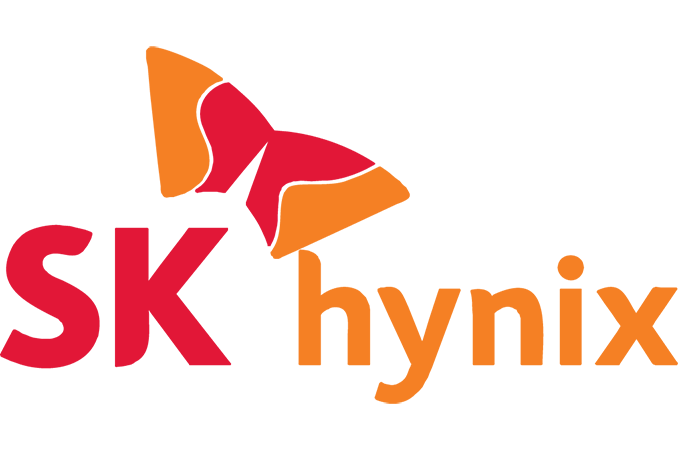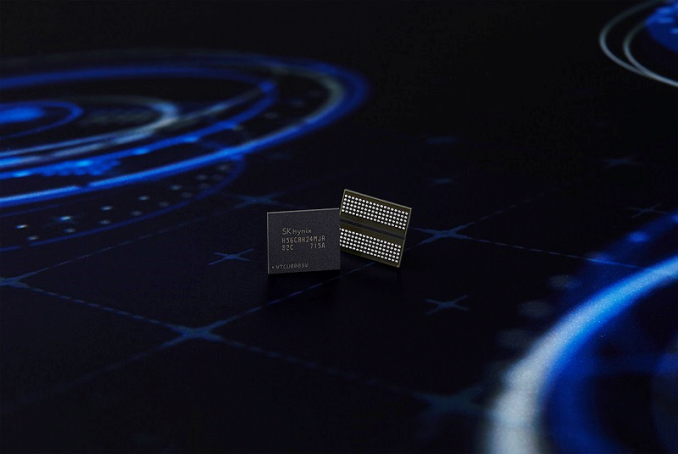SK Hynix Advances Graphics DRAM: GDDR6 Added to Catalogue, GDDR5 Gets Faster
by Anton Shilov on May 20, 2017 9:00 AM EST
SK Hynix has added GDDR6 memory chips to its product catalogue, revealing their general specifications and launch timeframe sometimes in Q4 2017. As expected, the new GDDR6 ICs will be available late this year and will run at speeds not achievable by GDDR5. GDDR5 is not really going away as SK Hynix has added several new SKUs into the catalogue, targeting forthcoming applications.
SK Hynix formally announced plans to produce GDDR6 in late April, so the addition of appropriate chips to the company’s databook does not really come as a surprise. The initial GDDR6 chips from SK Hynix will have an 8 Gb capacity and will feature 12 and 14 GT/s data transfer rates at 1.35 V. The new memory ICs will have a dual-channel 256Mx32 organization, which may indicate that GDDR6 chips will keep using 32-bit physical interface, but that I/O will operate as two 16-bit interfaces at all times to increase effective utilization of the bus (but this is a speculation at this point). The ICs will use 180-ball FCBGA packages and will thus be incompatible with existing GDDR5 and GDDR5X applications that use 170-ball and 190-ball form-factors, respectively.
| Specifications of SK Hynix's Upcoming 8 Gb GDDR6 and GDDR5 Memory Chips |
|||||||
| Part Number | Spec / FCBGA |
Data Rate | Bandwidth per Chip |
Voltage | Market | ||
| H56C8H24MJR-S2C | GDDR6 180-ball |
14 GT/s | 56 GB/s | 1.35V | Q4'17 | ||
| H56C8H24MJR-S0C | 12 GT/s | 48 GB/s | |||||
| H5GQ8H24AJR-R8C | GDDR5 170-ball |
10 GT/s | 40 GB/s | 1.55V | |||
| H5GQ8H24AJR-R6C | 9 GT/s | 36 GB/s | |||||
| H5GC8H24AJR-R2C | 8 GT/s | 32 GB/s | 1.50V | ||||
| 7 GT/s | 28 GB/s | 1.35V | |||||
| H5GC8H24AJR-R0C | 7 GT/s | 28 GB/s | 1.5V | ||||
| 6 GT/s | 24 GB/s | 1.35V | |||||
JEDEC yet has to finalize and publish specifications of GDDR6 and this is when we learn everything about peculiarities of the new memory. From SK Hynix we already know that the maximum planned data rate of the new memory will be 16 GT/s, implying a 16n prefetch and higher base clocks. We also know that one of the first graphics cards to use GDDR6 will have a 384-bit memory sub-system and assuming that it will run DRAM at 14 GT/s, it will feature 672 GB/s of bandwidth. Keep in mind that developers of GPUs and makers of graphics cards are rather conservative about memory frequencies, so, the final bandwidth could be lower, depending on yields of GPUs, DRAM ICs and graphics cards.
Besides GDDR6 memory, SK Hynix will also release 8 Gb GDDR5 chips rated for 9 and 10 GT/s data transfer rates at 1.55 V in Q4 2017. The new chips will target mass market applications that require higher memory bandwidth as well as cost efficiency of GDDR5, so, think of mainstream graphics cards. In addition to ultra high-speed GDDR5 devices, SK Hynix will also offer 7 and 8 GT/s GDDR5 chips with reduced voltages in the fourth quarter. The insertion of the new chips into the roadmap indicates that GDDR5 will remain on the market for at least a couple of years down the road and will celebrate a decade on the market next year.
| Specifications of SK Hynix's HBM2 Memory Chips | ||||||||
| Part Number | Density | Data Rate | Bandwidth per Stack |
Packaging | Feature | Availability | ||
| H5VR32ESM4H-12C | 4 GB | 1.6 GT/s | 204 GB/s | 5mKGSD | 4Hi stack, 1.2V | Q2'17 | ||
Speaking of graphics memory in general, it is also noteworthy that SK Hynix has removed mentions about HBM2 chips with 2 GT/s data rate from its product catalogue last quarter. As of now, the only HBM2 offering listed by the company are 4 GB 4Hi stacks with 1.6 GT/s data rate. The reasons for the move are unknown, but it is logical to assume that it is not easy to make very complex memory devices with a 512-bit I/O bus and high frequencies both from yields and from thermal points of view. Therefore, for products like AMD’s upcoming Radeon RX Vega, SK Hynix will have to offer HBM2 chips with 1.6 GT/s data rate and 204.8 GB/s bandwidth and it will be up to the buyers of such chips to implement further binning to higher frequencies.
Related Reading:
- SK Hynix to Ship GDDR6 Memory for Graphics Cards by Early 2018
- GeForce GTX 1080 Price Cut to $499; NVIDIA Partners To Begin Selling 10-Series Cards With Faster Memory
- Hot Chips 2016: Memory Vendors Discuss Ideas for Future Memory Tech - DDR5, Cheap HBM, & More
- Micron Confirms Mass Production of GDDR5X Memory
Source: SK Hynix











16 Comments
View All Comments
haukionkannel - Sunday, May 21, 2017 - link
The cheap cards could use DDR memory instead of gddr memory. Like it has been decades in very low budget cards. Also older type of memory has been done in older factories because of production costs. So gddr5 may remain with gddr6 for some years.DanNeely - Sunday, May 21, 2017 - link
Yeah, the lowest end cards will probably linger with standard DDR4 (which to be fair will be a decent upgrade over the DDR3 currently being used); and legacy products are rarely moved to new fabs while their volume is declining to end of life. My point is that old versions of GDDR have always stopped being used very shortly after the new one came out; and to ask if there's any reason why we shouldn't expect it to happen this time around.Alexvrb - Wednesday, May 24, 2017 - link
I don't think so. DDR-equipped cards will struggle to compete with APUs at this point. Even a lowly RX 550 or GT 1030 uses GDDR5. My suspicion is that entry-level GDDR5 will fill the low-end until GDDR6 becomes as cheap or cheaper. Higher-speed GDDR5/6 will fill in the rest of the lineup until you get to top cards, which will be HBM of some variety.The high density and bandwidth per pin may also allow HBM to see some on-package use as VRAM or VRAM cache on high-end APUs... eventually. I don't think we'll see that this generation, though. DDR4 plus more efficient architectures will give Raven Ridge enough breathing room that it won't be necessary yet.
Stochastic - Sunday, May 21, 2017 - link
So when can be expect HBM3?Stochastic - Sunday, May 21, 2017 - link
Hmmm, according to Wikipedia "No release date has been announced, though Samsung expects volume production by 2020."fanofanand - Wednesday, May 24, 2017 - link
GDDR5X is curiously missing from the table, should we assume that GDDR5X was merely a stopgap until GDDR6 arrived?